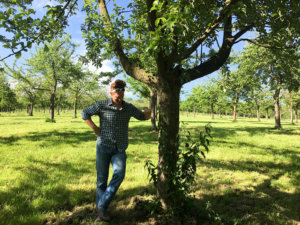French Cider Production: Keeving and Keeved Cider
Howdy cider fans.
There is a lot of mystery surrounding French cider, and French production methods. Techniques like keeving still used in France today date back to the 1700’s and are a mystery to even commercial cidermakers, much less the casual cider aficionado.
So, you are not alone in wondering, ‘What the heck is ‘Keeving’ anyway?’
The keeving process is a technique of wild fermentation that is performed extremely slowly under nutrient deficient conditions to achieve a specific flavor profile and end fermentation with residual sugars naturally present.

That is still pretty confusing, but I was lucky enough to take two expeditions to France this summer to learn all about keeving and the French style of cider production in the regions of Normandy, Brittany, and Perche.
I learned a lot in France and gave a lecture on keeved cider to the Northwest Cidermaker’s Association earlier this month. There is also a really cool article that was published in Draft magazine where writer Zach Fowle & I discuss Keeving. Check it out here. The following is a very brief outline on French style cider and the magic of keeving.
First off, what are we talking about when we talk about ‘French Style’ cider? Well, we are talking about a cider that is rich, lush, amber and full of bittersweet over-ripe apple character. French cider is always low in acidity, but well-balanced between the full-bodied sweetness and the large tannin profile (astringency). Some French style ciders tend to have an overwhelming fruit-forward charter (dried apple, apple blossom, cooked apple juice), while others are extreme examples of what you might call ‘barnyard’ or ‘farmhouse’ (manure, hay, horse-blanket). In my opinion the best French ciders have a little of both – lots of fruit but a touch of wild character to keep it interesting!
So how do you get this magical profile? The answer lies in the apples and how you ferment them. First you need to use bittersweet apples. Tannic, low-acid traditional French cider apples give you the proper flavor profile. American varieties make great cider, but not ‘French Style’ cider.
Next you must grind the apples and let them sit in contact with the skins for a period of time. This helps with getting that nice amber color and helps get full extraction of the juice and proper tannins.
After pressing the apples you start the keeving process. This involves letting the natural pectin in the fruit start to conglomerate and gel up (remember pectin is what causes jams and jellies to ‘set’). This happens slowly at cold temperatures and after a week, the pectin jelly starts rising to the top of the fermentation vessel. As the pectin moves to the top layer of the tank, it helps clarify the juice. The heavy solids drop to the bottom of the vessel in the middle you have an over-clarified, nutrient deficient juice.
Nutrient deficient? Yep. In modern winemaking, most winemakers and cidermakers add nutrients for the yeast to feed on to have a healthy and vigorous fermentation. In French cidermaking, the goal is the opposite and creating the pectin layer helps to filter out excess nutrients and yeast. Cidermakers siphon off the over-clarified, nutrient deficient juice out from under the pectin layer. This juice is wild-fermented extremely slowly with low populations of yeast at cold temperatures for 3-6 months.

Dave, head cidermaker, visiting a cider apple orchard in Normandy.
Over time, the already low population of wild yeast slows down and begins to die off before all the sugars are fermented into alcohol. If you time it right, you can put the cider into a bottle and get that last little bit of fermentation to give you carbonation before the yeast die. This process is not super reliable so many cider makers in France will carbonate the cider with gas and bottle, or pasteurize the cider. Either way, the result is phenomenal: rich, lush, bitter and sweet with a kiss of farmhouse. It takes a lot of time and effort, but is totally worth it!
I have to say I am super stoked about our 2016 Vintage Cidre Bouche that is releasing September 30th 2017.
We started with traditional French bittersweet cider varieties grown right here in the Willamette Valley. After months of fermentation, it was further aged in French Oak casks before bottling. It was a whole year in the making and what a ‘wild’ ride it has been.
Cheers.
~ Dave Takush